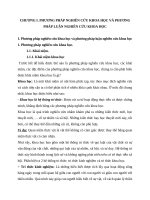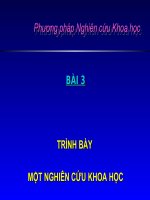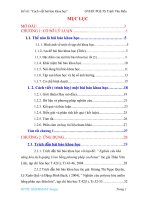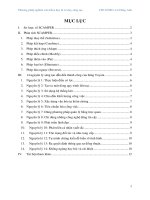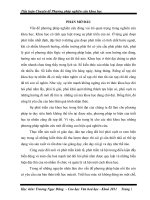Phương pháp nghiên cứu khoa học
Bạn đang xem bản rút gọn của tài liệu. Xem và tải ngay bản đầy đủ của tài liệu tại đây (155.91 KB, 22 trang )
VIETNAMESE EFL UNIVERSITY STUDENTS’
ATTITUDES TOWARD UTILIZING QUIZIZZ IN
ENGLISH VOCABULARY LEARNING
STUDENT’S NAME:
STUDENT CODE:
LECTURER:
TABLE OF CONTENTS
ABSTRACT.................................................................................................................1
CHAPTER 1. INTRODUCTION.............................................................................2
1.1. Background of the study............................................................................................2
1.2. Research problem.......................................................................................................3
1.3. Research purposes......................................................................................................3
1.4. Research questions......................................................................................................3
1.5. Definition of Terms.....................................................................................................3
1.6. Significance of the study.............................................................................................4
CHAPTER 2. LITERATURE REVIEW.................................................................5
2.1. Review of related literature.......................................................................................5
2.1.1. Vocabulary learning...............................................................................................5
2.1.2. Technology in Language Learning........................................................................5
2.2. Previous research........................................................................................................7
CHAPTER 3. CHAPTER 3: METHODOLOGY.................................................10
3.1. Research design.........................................................................................................10
3.2. Population & Sample................................................................................................10
3.3. Research instruments...............................................................................................10
3.3.1. Questionnaire.......................................................................................................10
3.3.2. Interview..............................................................................................................11
3.4. Research procedures................................................................................................11
3.5. Data analysis instruments........................................................................................11
3.5.1. Quantitative data..................................................................................................11
3.5.2. Qualitative data....................................................................................................12
CHAPTER 4. FINDINGS.......................................................................................13
CHAPTER 5. DISCUSSIONS AND CONCLUSIONS.........................................14
REFERENCES..........................................................................................................15
APPENDICES............................................................................................................ 19
ABSTRACT
Vocabulary is an important part of language learning, as it enables language use
and is the heart of four language skills. Technology has had a major impact on
teaching and learning methods, such as using smartphones and tablets. Quizizz is an
effective tool for teaching vocabulary and creating a more efficient language learning
experience with features such as avatars, music, memes, and themes. This study aims
to understand the Vietnamese EFL students' perceptions of Quizizz, including how
pleased they are with it, its pros and cons, and recommendations for using it to study
English vocabulary. A mixed-method approach is employed to investigate how EFL
university students feel about using Quizizz to acquire vocabulary. The researcher uses
semi-structured interviews to collect precise data on the ideas, emotions, and attitudes
of the students. The qualitative data are derived from both the open-ended component
of the questionnaire and the interviews and evaluated using a thematic analysis
technique. The research is expected to reveal that students are highly satisfied with
Quizizz for vocabulary learning, and the application has several key advantages and
disadvantages. It could also have implications for improving academic success and
motivation among Vietnamese EFL students and could help educate policymakers and
educators on how to better utilize technology and engaging methods to support
vocabulary learning.
Keyword: Vocabulary learning, EFL, MALL, attitude, Quizizz
1
CHAPTER 1. INTRODUCTION
1.1. Background of the study
In the past 10 years, technology has influenced every aspect of our lives,
including work, education, and even leisure. Additionally, it has been included in the
field of computer-assisted language learning (CALL) as well as the topic of mobile
assisted language learning (MALL) (Hellmich, 2021). Academics claim that MALL
has recently been shown to be a powerful tool for improving English language
teaching and learning (Panagiotis & Krystalli, 2020). Learning extends outside of the
classroom with the emergence of mobile learning (as a contemporary sub-field) in the
context of teaching English as a second language (ESL) or foreign language (EFL)
(Lin & Chen 2017).
Vocabulary development is one of the most crucial aspects of learning a
language, according to numerous experts (e.g., Nation, 2001; Richards & Renandya,
2002; Schmitt, 2010). Students may utilize it to support four linguistic capacities.
Vocabulary is crucial at all phases of a learner's language development, as Balci and
Çakir (2012) found. Furthermore, a student cannot communicate without the necessary
language. The truth is that while communication may happen without syntax and
grammar, it cannot happen without vocabulary, according to a number of vocabulary
experts (e.g., Willis, 1990; Lewis, 1993; Folse, 2004). Illiterate kids would thus surely
find it difficult to communicate their thoughts, feelings, and ideas, as well as grasp the
significance of both spoken and written materials. A strong grasp of vocabulary is
crucial for enhancing one's linguistic ability (Boers & Lindstromberg, 2008).
According to Eagly and Chaiken (1993, p. 1), attitude is "a psychological
tendency that is represented by judging a particular thing with some degree of favor
and dislike," and it is made up of three parts: cognitive, emotional, and behavioral
components. (Luu, 2011). Kara (2009) asserts that both behavior and performance are
significantly influenced by a learner's attitude. Students' attitudes can influence how
they comprehend the world, feel about it, and act. In other words, attitude is thought to
influence all choices and behaviors (e.g., Brown, 2001; Eagly & Chaiken, 1993; Tran,
Duong, & Huynh, 2019; Tran & Seepho, 2016; Tran & Tran, 2017). "Attitudes and
beliefs are a subset of a collection of constructs that name, define, and characterize the
structure and content of mental states that are assumed to influence a person's
behaviors," claims Richardson (1996, p.102). Additionally, Dörnyei (2007) asserts that
2
attitudes as well as intelligence play a role in the effectiveness of language learning.
Academically speaking, Ellis (1994) notes that the attitudes of students have been
established as a key factor in learning outcomes. Positive and negative attitudes are
two different types of inclinations. A student who is passionate about learning a
language will work hard in class and put a lot of effort into their studies. Contrarily,
unfavorable attitudes might make language learning less continuous.
1.2. Research problem
Many findings have been encouraging (see, Göksün & Gürsoy, 2019; Jannah et
al., 2020; Zhao, 2019), with Quizizz improving vocabulary and perseverance more
than conventional approaches. Additionally, Quizizz increased favorable interest,
focus, attitudes, and motivation (Zuhriyah & Pratolo, 2020). However, there is not
much research on how Vietnamese EFL university students feel about using Quizizz to
acquire English vocabulary. This study attempts to investigate how Vietnamese EFL
university students feel about using Quizizz to acquire English vocabulary.
1.3. Research purposes
The study aims to:
1) Examine how satisfied Vietnamese university students are with Quizizz's
use for learning vocabulary in English.
2) Understand the benefits and drawbacks of Quizizz for Vietnamese
university students learning English vocabulary.
3) Look at suggestions made by Vietnamese university students for using
Quizizz to acquire English vocabulary.
1.4. Research questions
This study aims to respond to the following research questions in order to
comprehend the students' perception of Quizizz:
1) How pleased are the students using Quizizz for learning English
vocabulary?
2) According to the students, what are the pros and cons of utilizing Quizizz to
learn English vocabulary?
3) What recommendations do the students have for using Quizizz to study
English vocabulary?
3
1.5. Definition of Terms
The following definitions are offered to help readers understand the words used
in this study:
- Attitude is defined as one's thoughts and feelings toward something. The
views of students regarding utilizing Quizizz for vocabulary acquisition were
examined in this study.
- Quizizz is an educational application that has been gamified and lets students
study and test their knowledge. Quizizz was employed in the current study as a
vocabulary learning and review tool.
- Vocabulary learning is the process of studying words in terms of their
meanings and functions.
1.6. Significance of the study
The goal of the proposed study is to assess students' perceptions of Quizizz's
usefulness. This app is one of the digital age's vocabulary teaching techniques that
provides a fun experience while expanding students' vocabulary understanding. From
the standpoint of the researcher, Quizizz performs the impressive function of
transforming a conventional, teacher-centered classroom into one that is engaging and
interactive and places students at the center of the learning process. The use of Quizizz
in vocabulary acquisition is likely to increase students' motivation to learn new words
and engage in the activities. As a result, it could be advantageous for educators who
are interested in adapting this approach of instruction. Therefore, the study's findings
may be helpful for teachers and educators to be more conscious of the need to find
other teaching alternatives and instructional materials that are appropriate for and more
engaging for students in today's digital society.
4
CHAPTER 1.
LITERATURE REVIEW
1.7. Review of related literature
1.7.1. Vocabulary learning
Vocabulary is an important feature of language and one of the required
components for English learning as a foreign language (EFL) (Alsalihi, 2020). It is a
potent carrier of word and meaning information (Hubbard, 1983; Diamond & Gutlohn,
2006). Vocabulary knowledge is vital in acquiring L2 skills because second language
learners must utilize their vocabulary knowledge to develop understanding and
accurately express their thoughts to readers or listeners in order to satisfy their
communication demands (Hatch & Brown, 1995). A lack of vocabulary causes
difficulties in all four skills: hearing, speaking, reading, and writing. As a result, it is
critical to teach and learn vocabulary.
Vietnam has a growing economic connection with the rest of the world, making
English the most widely spoken foreign language. It is a required subject in the
secondary school curriculum and is also introduced as a topic in several provinces.
English language centers around the nation, as well as the investment made by
Vietnamese parents in pricey English courses, demonstrate the importance of English
in Vietnam. However, the quality of English language training (ELT) in Vietnam is
often inadequate (Nguyen & Nguyen, 2019), with a considerable percentage of
Vietnamese learners unable to communicate in English for daily purposes, according
to a survey (Le, 2015). To address this, the National Foreign Language Project 2020
has been launched to reform the learning and teaching of English and other foreign
languages in Vietnam, with the goal of improving the foreign language competence of
Vietnamese postsecondary graduates and the workforce.
1.7.2. Technology in Language Learning
Mobile-assisted Language Learning and Vocabulary Learning
Mobile-assisted language learning (MALL) is the use of mobile devices like
smartphones to aid with language acquisition (Hulme, 2012). It can be used alone or in
groups to practice reading, listening, speaking, and writing in the target language, and
provides students with real-time, convenient, and contextual learning possibilities.
When used responsibly, MALL can help students improve their academic performance
(Ivi & Jakopec, 2016), and contribute to favorable learning outcomes (Burston, 2013).
It also enhances positive attitudes and intentions toward learning, and can be used to
5
improve one's vocabulary (Griffiths, 2013). There are several programs available on
mobile devices that instructors can use to best fit their goals in the classroom.
Games and gamification
Games have been shown to improve communication success in language
acquisition by simplifying problems and providing a relaxed and enjoyable learning
atmosphere. They alleviate the fear of receiving unfavorable feedback or being
scrutinized by others in public and offer a stimulating and entertaining motivator
(Dornyei & Csizer, 2002). Gamification is defined as the application of game
mechanics and game-design strategies in situations other than those of actual games
(Werbach & Hunter, 2012). When used properly in schools, gamification can be used
to entice and stimulate learners (Lee & Hammer, 2011). Gamification is a technique
used to motivate and reinforce student learning by fusing extrinsic and intrinsic
motives (Flatla, 2011).
Kim (2015) sees Quizizz as both a game and gamification since it keeps kids
entertained while also encouraging and reinforcing their language learning. According
to Kim, the nature of the issue that gamification seeks to address distinguishes it from
games.
Quizizz Aplication
Quizizz is an internet learning website that assists young learners in developing
an interest in studying and answering questions in a number of academic areas. It is a
game-based educational tool that makes in-class practice simple and enjoyable while
bringing multiplayer activities to the classroom. Quizizz offers avatars, themes,
memes, and music to make studying fun. In the classroom, students take quizzes at the
same time and track their standings on leaderboards. This program is intended to
energize, inspire, and increase students' involvement (Zhao, 2019). The four primary
Quizizz elements used in the study were a Lesson, Live game, Homework, and
Flashcard. The descriptions of each feature are given:
The Lesson is a key component used in the current study. It helps the instructor
create and distribute a slideshow that may be shown to the class or given as
homework. Teachers can use Quizizz slide choices for information and media, and
upload already-created PowerPoint or Google Slides presentations. The instructional
slides may be shared with students after the presentation has been created using a code
or particular URL (Ferlazzo, 2020).
6
The Live Game feature allows users to take a quiz in real-time using the "Play
Live" button. They have the option of playing in test, team, or classic modes. The
instructor can view a live dashboard showing real-time scores as the students are
participating in the live game on their own devices. Students can access the quiz from
any device, including a desktop computer, tablet, or smartphone, and can play the
game whenever it suits them. However, a game code is only valid for a short period of
time (Shamil, 2019).
The Homework option enables teachers to specify the exam deadline and provide
students with a code to complete the question on their own time. Immediately
following the test, students may see their test results and real-time student progress on
the report page. This allows teachers to assess student replies to each question or look
at responses from specific students to identify areas that need to be retaught (Shamil,
2019).
Students can access the Flashcard option after finishing the teacher-hosted quiz.
It is up to them to decide whether or not to use them. Flashcards are used to compile a
library of visually appealing terminology and create a visual connection between the
L1 and the target language. Any level of student can use flashcards to practice
sentence structure and word order as well as for a number of other activities.
1.8. Previous research
In research published in 2019, Göksün and Gürsoy used Kahoot and Quizizz as
formative assessment tools to examine how gamification activities affected academic
attainment and student engagement. Three groups of 97 pre-service teachers made up
the participants. The Kahoot experiment group consisted of the first 30 instructors. 33
instructors were given the Quizizz experiment, while 34 teachers served as the control
group. An academic achievement exam, a student engagement measure, and focus
group interviews were the three methods used to gather the data. The results showed
that the applications strengthened the students' subject knowledge, and since they were
aware of the pre-class tests, they arrived prepared to class, which was attributed to the
applications' motivational effects on the students. Furthermore, the Quizizz group was
found to have more attentive students because of the post-instruction quiz than the
Kahoot group, according to the interviews that were done with them.
Dewi et al. (2020) conducted research to determine the impact of the MALL
method on students' understanding of grammar in higher education. 246 individuals
7
taking the English Complex Grammar course served as study subjects and were split
into the experimental group and the control group. The results revealed that using the
Quizizz program and the MALL approach greatly increased students' grammatical
proficiency, with the experimental group's average score on Quizizz being 84.21. The
control group had an average score of 78.15. The experimental group was able to
obtain better results than the control group based on the mean scores of both groups.
An investigation was conducted by Jannah et al. (2020) to learn how EFL
students felt about taking Quizizz's online English exams. At MAN 3 Banjarmasin
School, 212 students in grades 11 and 12 participated in the study. The researcher gave
the students the questionnaire, which was made up of both open-ended and closedended questions, in order to rectify the data processing. The results revealed that
participants had favorable sentiments regarding taking Quizizz's online English
examinations. Due to elements like gaming that Quizizz offers, students enjoyed
taking the online evaluation there. Additionally, since students could take the test at
any time and anyplace outside of class, using Quizizz was more efficient and timesaving. Few students, meanwhile, concurred that utilizing the tool to take a test
lessened their exam anxiety.
The goal of Zuhriyah and Pratolo's (2020) study was to investigate how students
felt about using Quizizz as an evaluation tool in an English lesson. Six people were
chosen from an English class at a private institution in Yorkyakarta, Indonesia, and
their opinions were gathered through interviews. The study's conclusions pointed to
four important effects of using the Quizizz app: it served as a helpful and engaging
tool for university-level English vocabulary study, it gave students more selfconfidence, it improved their reading skills, and it helped inspire them to pay attention
in class.
Research has shown that acquiring vocabulary is a key component of learning a
new language. Finding innovative and effective teaching and learning techniques to
produce powerful stimuli for students to acquire L2 vocabulary is a constant challenge.
Quizizz is one of the practical strategies that many researchers have suggested, as it
encourages student participation in the learning process and improves learners'
engagement. Additionally, it aids students in improving their word memorization.
Students felt that this method of teaching was enjoyable and improved the classroom
environment, inspiring them to study the target language more in the future. However,
there hasn't been any study done to date on how Vietnamese EFL students feel about
8
using Quizizz to help them acquire vocabulary. As a result, the current study set out to
look into 1) students' satisfaction with using Quizizz to learn English vocabulary, 2)
students' perceptions of the benefits and drawbacks of using Quizizz to learn English
vocabulary, and 3) students' suggestions for using Quizizz to learn English vocabulary.
9
CHAPTER 2. CHAPTER 3: METHODOLOGY
2.1. Research design
This study uses a mixed-methods approach to investigate how EFL university
students feel about using Quizizz to acquire vocabulary. A questionnaire is used to
acquire information, and semi-structured interviews are used to gather detailed
information that cannot be obtained from questionnaires..
2.2. Population & Sample
Participants in this study are EFL college students from Vietnam who are
enrolled at a university in Hanoi. They will be picked using simple random sampling
from students of all of Thang Long University's majors, with the exception of the
English language major. There will be about 50 second- or third-year students in
attendance.
The tutorial will be held during the first stage of the research to teach students
how to use the Quizizz app.
2.3. Research instruments
2.3.1. Questionnaire
The questionnaire will examine participants' perspectives on using Quizizz to
learn vocabulary in terms of benefits, drawbacks, satisfaction, and suggestions. It will
be prepared in both English and Vietnamese and will be emailed to participants after
the course. Three sections will be made up of the questionnaire:
Part 1: Participants' demographic data, such as age, gender, and Quizizz usage
history, is gathered.
Part 2: Participants are asked to rate their level of agreement with ten closedended statements on a scale of 1 to 5:
1 = Strongly disagree
2 = Disagree
3 = Undecided
4 = Agree
5 = Strongly agree
Part 3: Participants were asked for their thoughts and suggestions on using
Quizizz to learn the language.
10
2.3.2. Interview
After distributing the questionnaire, the researcher uses semi-structured
interviews to collect detailed data on the ideas, emotions, and attitudes of students. Ten
different individuals will each have a face-to-face interview, which will last between
ten and fifteen minutes and be voice-recorded.
2.4. Research procedures
Within a month of 2023, the researcher instructs participants on how to use
Quizizz on their mobile devices for two weeks and then asks them to practice 200
target vocabulary words. They are also asked to respond to a questionnaire on how
they feel about using Quizizz to help them learn new words, and several of them are
chosen for in-depth interviews. The researcher then examines the information gleaned
from the questionnaires and interviews.
Stage
s
1
2
3
4
5
Detail
Quizizz tutorial session
Implementing Quizizz for 2 weeks
Administering the questionnaire
Conducting interviews with 10
Analysing the data
Time
Day 1
Day 2 – Day 15
Day 16
Day 17 – Day 18
Day 19 –
2.5. Data analysis instruments
The data in this study comprises both quantitative and qualitative information.
The quantitative data was gathered via a questionnaire, and the qualitative data was
derived from both the open-ended components of the questionnaire and the interviews.
2.5.1. Quantitative data
The quantitative data gathered from questionnaires is used to determine if there is
a significant difference between the values (Mean, Mode, Median) and the Standard
Deviation (S.D.). The average questionnaire values are interpreted as follows:
4.50 - 5.00 = Strongly agree
3.50 – 4.49 = Agree
2.50 – 3.49 = Undecided
1.50 – 2.49 = Disagree
1.00 – 1.49 = Strongly disagree
2.5.2. Qualitative data
The qualitative data gathered from questionnaires and interviews will be
evaluated using a thematic analysis technique. Braun and Clarke (2006) described the
11
steps involved in this strategy, which include transcribing, reading, and taking notes.
Code intriguing data aspects across the whole data collection and collapse data
relevant to each code. Look for themes that are aggregating codes into prospective
themes and accumulating all important data for each potential theme. Check to see if
the themes work with the coded extracts and the complete data set. Finally, offer the
report in the form of a narrative text.
12
CHAPTER 3. FINDINGS
Expected outcomes
This research is expected to produce several key findings. First, the research is
expected to reveal that students overall are highly satisfied with using Quizizz for
vocabulary learning. They report that they find the application to be both engaging and
comprehensive. Second, students' responses are expected to reveal that they perceive
Quizizz to have several key advantages for vocabulary learning, including its
interactive features and the variety of content and activities available. Additionally,
students are expected to report several disadvantages of using Quizizz for vocabulary
learning, such as the lack of audio or visual aids. Students will also be able to provide
specific suggestions for how Quizizz could be improved in the future. The potential
outcomes of this research are extensive, as it may have implications for improving
academic success and motivation among Vietnamese EFL students. Furthermore, the
findings could help educate policymakers and educators on how to better utilize
technology and engaging methods to support vocabulary learning in an EFL context.
13
CHAPTER 4. DISCUSSIONS AND CONCLUSIONS
Strengths
The strengths of using a mixed-method approach for this research include:
1. A more comprehensive understanding of students' attitudes, including their
satisfaction with using Quizizz for vocabulary learning.
2. More complete collection of data, including both quantitative and qualitative
data, that can be analyzed in an organized and scientific way.
3. More thorough and objective analysis of students' attitudes, allowing for a
more nuanced understanding of their views in future research.
Possible limitations
The scope of the current study was restricted to investigating the attitudes of 50
students enrolled in a university in Hanoi, Vietnam. As a result, the study's findings do
not accurately reflect the views of all Vietnamese students, hence, integrating a larger
sample size could help to generalize the results to a bigger population.
14
REFERENCES
Alsalihi, H. (2020). Posters in Vocabulary Learning. Arab World English Journal,
Special Issue on the English Language in Iraqi Context, 18-31.
Balci, Ö., & Çakir, A. (2012). Teaching vocabulary through collocations in EFL
classes: The case of Turkey. International Journal of Research Studies in
Language Learning, 1(1), 21-32. DOI: 10.5861/ijrsll.2012.v1i1.31
Boers, F., & Lindstromberg, S. (2008). How cognitive linguistics can foster effective
vocabulary teaching in F. Boers & S. Lindstromberg (Eds.), Applications of
cognitive linguistics: Cognitive linguistic Approaches to teaching vocabulary and
phraseology (pp.1-61). Berlin: Mouton de Gruyter.
Braun, V. & Clarke, V. (2006). Using thematic analysis in psychology. Qualitative
Research in Psychology, 3, 77–101.
Brown, J. D. (2001). Using Surveys in Language Programs. Cambridge, UK:
Cambridge University Press.
Burston, J. (2013). Mobile-assisted language learning: A selected annotated
bibliography of implementation studies 1994–2012. Language Learning &
Technology,
17(3),157–224.
Retrievable
from
/>D. Orhan Göksün & G. Gürsoy. (2019). “Comparing Success and Engagement in
Gamified Learn-ing Experiences via Kahoot and Quizizz,” Computers &
Education,
vol.
135,
pp.
15–29,
/>Dewi, K., Myartawan, I., Swari, N. & Sugihartini, N. (n.d.). Dewi, K. S. (2020).
Quizizz effect on students’ grammar mastery in higher EFL classroom based
mobile assisted language learning. LEJU, 3, 15-24.
Diamond, L. & Gutlohn, L. (2006). Teaching Vocabulary. Reading Rocket.
/>Dörnyei, Z. (2007). Research methods in applied linguistics. New York: Oxford
University Press.
15
Dornyei, Z. & Csizer, K. (2002). Motivational Dynamics in Second Language
Acquisition: Results of a Longitudinal Nationwide Survey. Applied Linguistics,
23, 421-462. />Eagly, A. H., & Chaiken, S. (1993). The psychology of attitudes. Orlando, FL, US:
Harcourt Brace Jovanovich College Publishers.
Ellis, R. (1994). The study of second language acquisition. Oxford: Oxford University
Press.
Ferlazzo, L. (2020). Quizizz adds features that makes it a simplified Nearpod. Edu
blogs.
/>
makes-it-a-simplified-nearpod.
Flatla, G. (2011). Calibration games: Making calibration tasks enjoyable by adding
motivating game elements. Proceedings of the 24th annual ACM symposium on
User interface software and technology, 403-412. Santa Barbara, California,
USA.
Folse, K. S. (2004). Vocabulary myths: Applying second language research to
classroom teaching. Ann Arbor, MI: University of Michigan Press.
Griffiths, M. (2013). Adolescent mobile phone addiction: a cause for concern.
Education and Health, 31(3), 76-78.
Hatch, E. & Brown, C. (1995). Vocabulary, Semantics, and Language Education.
Cambridge, England: Cambridge University Press.
Hellmich, E. A. (2021). CALL Beliefs in Context: A Study of US High School
Foreign Language Learners. Computer Assisted Language Learning, 34(7), 845–
867 />Hubbard, P. (1983). A training course for TEFL. Oxford, English: Oxford University
Press.
Ivić, V. & Jakopec, T. (2016). Using mobile application in foreign language learning:
a case study. Libellarium, 9(2), 217-230
Jannah, N. A., Supiani, N. & Perdana, I. (2020). The ELF students’ perceptions of
using Quizizz in doing online English test at high school. Proceeding of SHEPO,
128–130.
Kim, B. (2015). Understanding Gamification. Chicago: American Library Association.
16
Kukulska-Hulme, A. & Shield, L. (2008). An Overview of Mobile Assisted Language
Learning: From Content Delivery to Supported Collaboration and Interaction.
ReCALL, 20, 271-289.
Le, C.V (2020). English language education innovation for the Vietnamese secondary
school: The Project 2020. In Secondary School English in Asia: From Policy to
Practice; Spolsky, B., Sung, K., Eds.; Routledge: New York, NY, USA, 2015;
pp. 182–200.
Lee, J., & Hammer, J. (2011). Gamification in education: What, how, why bother?
Academic Exchange Quarterly, 15(2), 125-128.
Lewis, M. (1993). The lexical approach. Hove, UK: Language Teaching Publications.
Lin, M.-H., & Chen, H.-g. (2017). A Study of the Effects of Digital Learning on
Learning Motivation and Learning Outcome. Eurasia Journal of Mathematics,
Science
and
Technology
Education,
13(7),
3553–3564.
/>Luu, T. T. (2011). An Empirical research on self-learning vocabulary. Theory and
Practice in Language Studies. 1(2), 1688-1695. DOI: 10.4304/tpls.1.12.16881695
Nation, P. (2001). Learning vocabulary in another language. New York: Cambridge
University Press.
Nguyen, X.N.C.M.; Nguyen, V.H. (2019). Language education policy in Vietnam. In
The Routledge International Handbook of Language Education Policy in Asia;
Kirkpatrick, A., Liddicoat, A.J., Eds.; Routledge: London, UK; pp. 185–201.
Panagiotis, A., & Krystalli, P. (2020). Mobile-Assisted Language Learning (MALL):
Trends from 2010 to 2020 Using Text Analysis Techniques. European Journal of
Education, 3(3), 84–93. />Richards, J. C., & Renandya, W. A. (2002). Methodology in language teaching: An
anthology of current practice. Cambridge, England: Cambridge University Press.
Richardson, V. (1996). The role of attitudes and beliefs in learning to teach. In J.
Sikula (Ed.), Handbook of research on teacher education, 2nd ed. (pp. 102-119).
New York: Macmillan.
Schmitt, N. (2010). Researching vocabulary: A vocabulary research manual.
Basingstoke, England: Palgrave Macmillan.
17
Shamil.
(2019).
Hosting
a
live
game.
Quizizz
Help
Center.
/>Socialist Republic of Vietnam. (2008). Teaching and Learning Languages in the
National
Educational
System,
Period
2001–2020.
Available
online:
/>Tran T. Q., Duong, T. M., & Huynh, N. T. T. (2019). Attitudes toward the use of
TELL tools in English language learning among Vietnamese tertiary English
majors. VNU Journal of Social Sciences and Humanities, 5(5), 581-594. DOI:
/>Tran, T. N.P., & Tran, T. Q. (2017). Attitudes towards the Learning of culture in
English language learning among Vietnamese high school students. Proceedings
of the Third International TESOL Conference Promoting ELT: Diverse
Perspectives and New Horizons at Ho Chi Minh City University of Education
(pp.233-246). Ho Chi Minh City: Ho Chi Minh City University of Education
Publishing House.
Tran, T. Q., & Seepho, S. (2016). EFL learners’ attitudes toward intercultural
communicative language teaching and their intercultural communicative
competence development. Journal of English Studies, 11, 1-40.
Werbach, K. & Hunter, D. (2012). For the Win: How game thinking can revolutionize
your business. Wharton Digital Press.
Willis, D. (1990). The lexical syllabus: A new approach to language teaching. London:
Collins ELT.
Zhao, F. (2019). Using Quizizz to Integrate Fun Multiplayer Activity in the
Accounting Classroom. International Journal of Higher Education, 8(1), 37-43.
Zuhriyah, S. & Pratolo, B. W. (2020). Exploring Students’ Views in the Use of
Quizizz as an Assessment Tool in English as a Foreign Language (EFL) Class.
Universal Journal of Educational Research, 8(11), 5312 - 5317. [Original source:
/>
18
